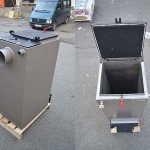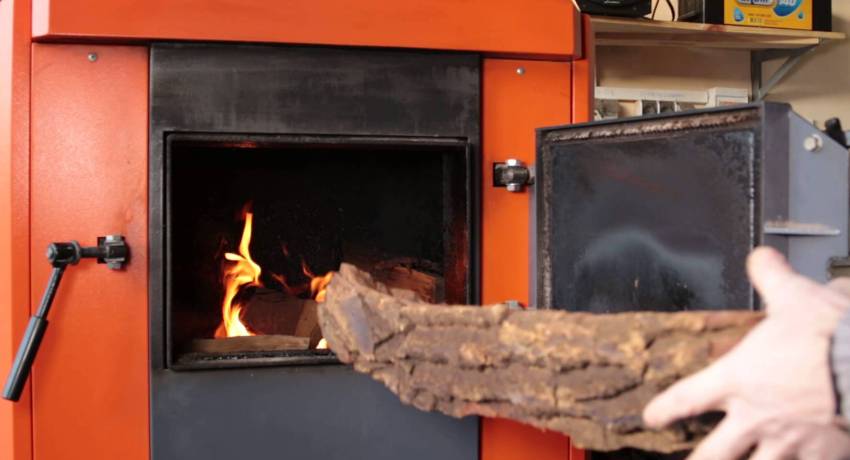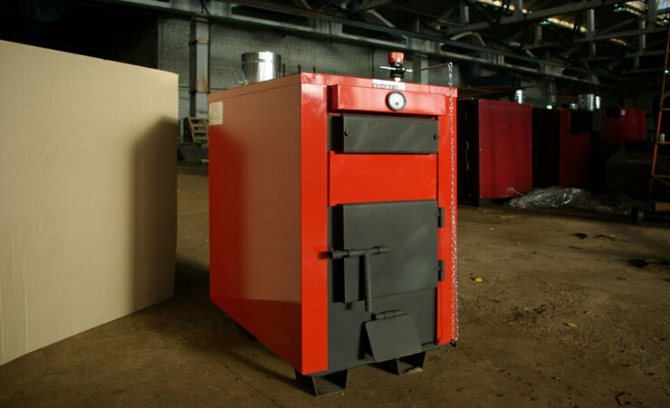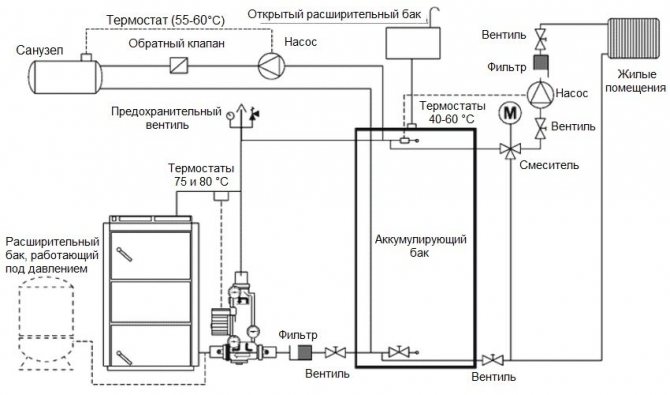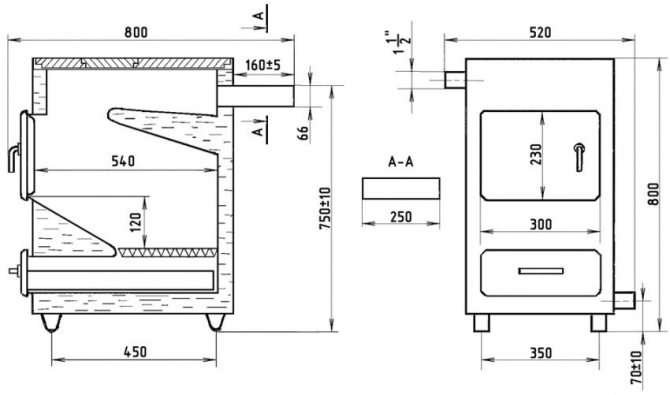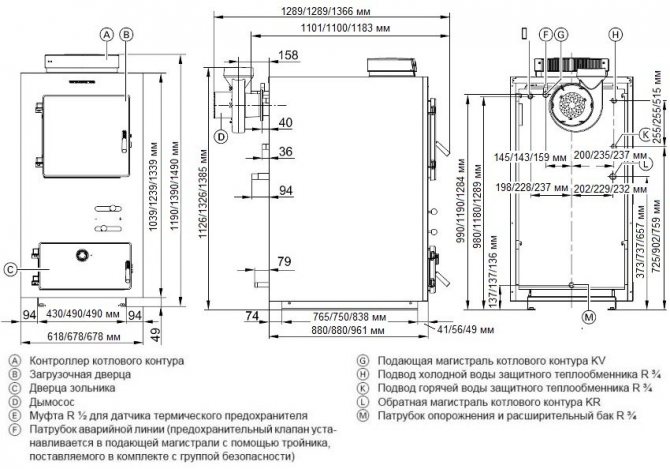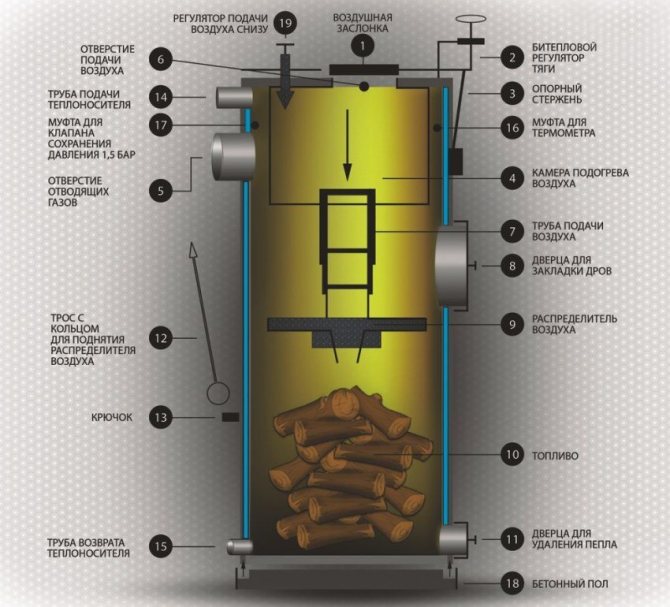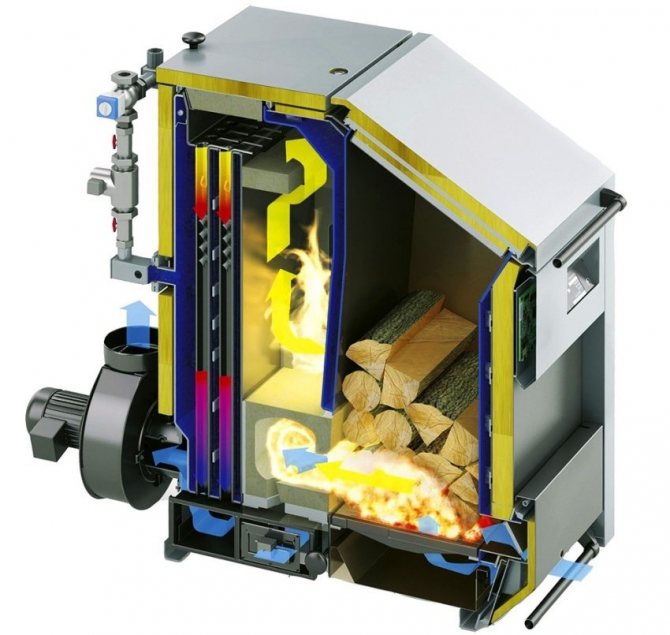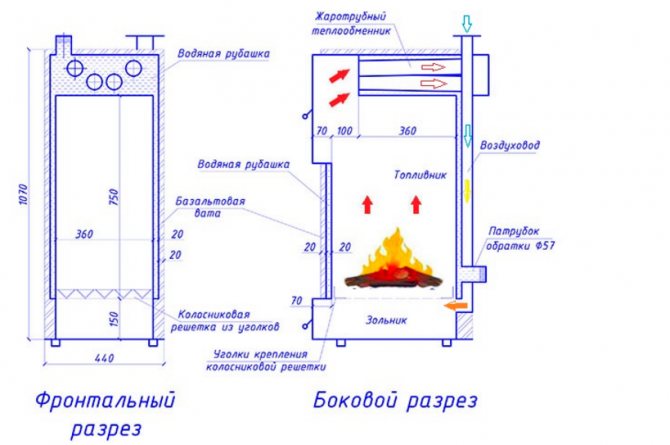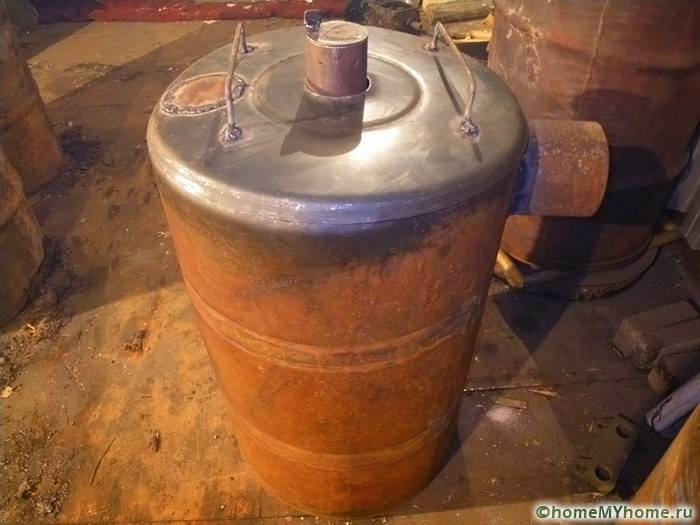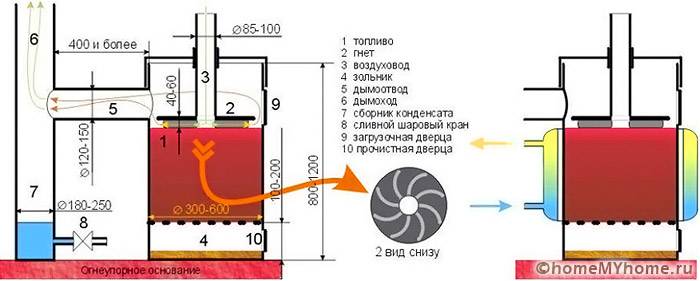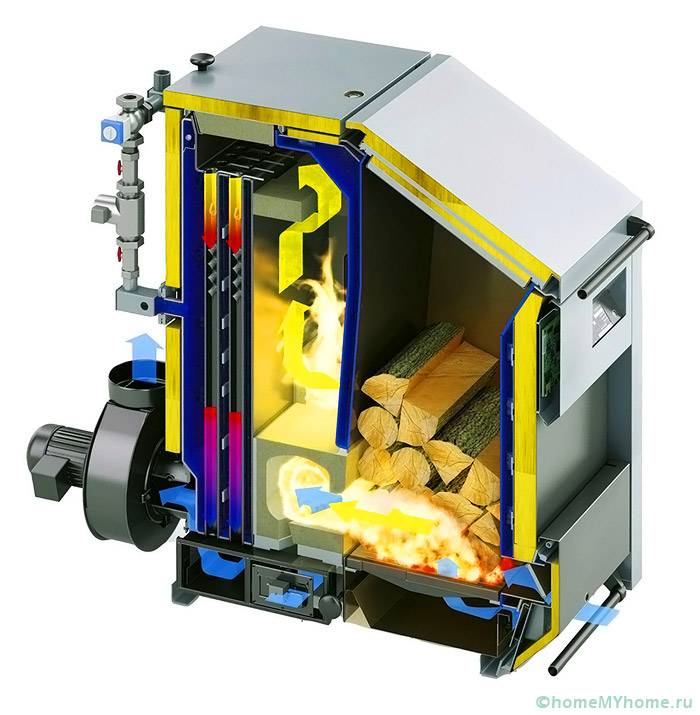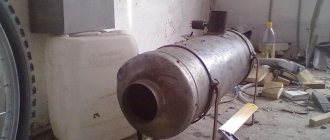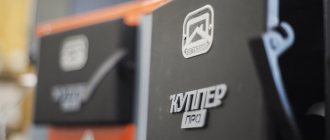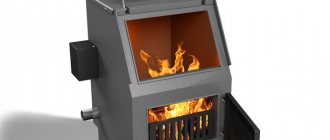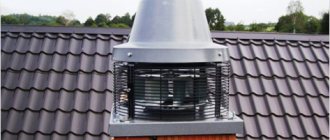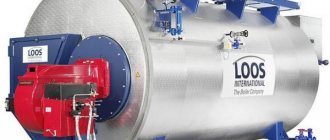Currently, most of the owners of private houses have gas heating. However, situations often arise when it is not possible to connect to the central gas pipe. Then solid fuel boilers, powerful and reliable heating devices come to the rescue. You can heat with wood or coal both in a private house and in the country. At a cost, this type of heating will be more expensive in comparison with gas heating. In terms of their technical parameters and manufacturability, modern models of solid fuel heating devices are practically not inferior to other types of boiler equipment.
Thanks to modern technologies, manufacturers have managed to achieve a significant duration of the combustion process in solid fuel units. A long-burning solid fuel heating boiler is by far the most economical and efficient type of boiler equipment. The undisputed leaders in this class are solid fuel shaft-type heating boilers. Such equipment has a simple design, so there are often cases when they try to make a mine boiler on their own.
Kholmov's boiler
This modification of the furnace differs in that it is equipped with two chambers - for installing a heat exchanger and separately for burning fuel. These devices with bottom combustion and full height of the furnace, which became the name for them. The principle of operation depends on the design.
The most popular today are two designs:
- Kholmov pyrolysis boilers (PC);
- normal combustion.
The fuel burns at the bottom of the closed combustion chamber. The second shaft is smaller, serves for afterburning flue gases and cooling them in the boiler for heating water for heating.
Non-volatile devices control the temperature with an RT3 thermostat installed at the front of the structure. For completeness of fuel combustion, the air supply to it is regulated by the blowing door located on the main door of the ash pan.
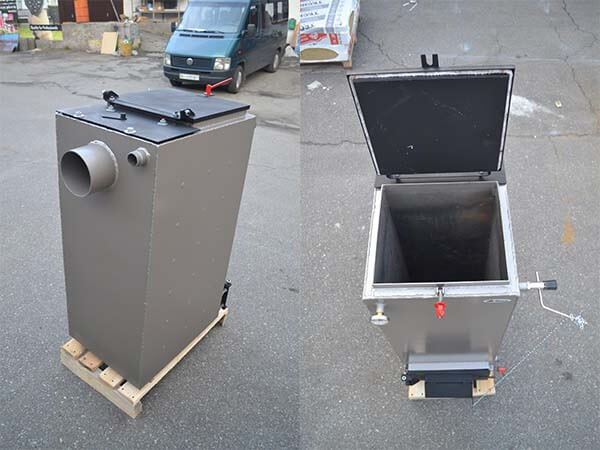
Kholmov's boiler. Top and side view
A special restriction shutter is installed to ensure the minimum air passage. In the upper rear part of the unit there is a branch pipe for connecting a chimney that provides natural draft.
The boiler is equipped with a shut-off valve and compensators on the outside and inside the casing, designed to prevent weld seams from bursting during emergency overheating.
How to determine the efficiency of a boiler


After installation, the boiler must be tested. To do this, fill the furnace with weighed portion of homogeneous dry firewood, the heating system is connected.
Three parameters are measured: water volume, start temperature, end temperature, duration of burning. Based on these data, the amount of energy transferred to the coolant is calculated.
The resulting value is compared with the calorific value of the fuel. If the numbers are different by 20% - the system works "perfectly".
Boiler working principle
The heat generation process takes place in two ways: direct combustion of natural fuel and afterburning of a pyrolysis gas mixture formed due to lack of air. Some of the fuel smolders, giving off tar and soot smoke. Further, the gases migrate through the coals, saturated with combustible components, and turn into a gas-combustible mixture.
These units are of the mine type - with bottom combustion. The process is carried out at the level of 20.0 cm in the lower zone of the furnace space. The upper fuel waits in hot reserve while the lower one burns out. Flue gases collect about 30.0 cm above the fuel.
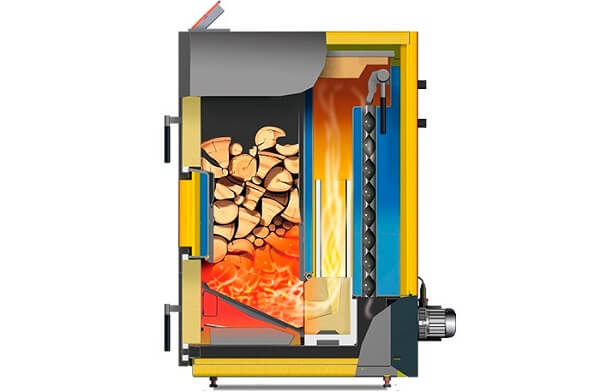

The main volume of primary air falls under the grate and moves to the part of the pyrolysis afterburner. It captures flue gases above the combustion level.
The mines are separated by a partition having a small gap at the bottom, through which the flame is drawn by thrust from the first chamber to the other, where the complete afterburning of combustible gases is completed, washing the convection heat exchanger from T +850 C.
The heating circuit in the water jacket of the mine-type boiler is subjected to radiation heating, the residual heat is transferred to the convection-type heat exchanger.
Heating unit
The first step in making a mine boiler is to assemble the firebox housing. It is made from metal parts, the thickness of which is 4 mm. They need to be tacked by welding. It is worth starting from the bottom, where the side parts, the vault cover, and the holes for the doors will be attached. It should look something like the photo:


Welding walls
You need to follow the drawing. The bottom sheet should be extended in each direction. It will also serve as the lower part of the ash compartment doors. In the chamber, it will be necessary to fix the shelves by welding. The corners were indicated in the materials. There will be a grate. After welding, it is important to check each compartment for leaks, carefully boiling all the joints.
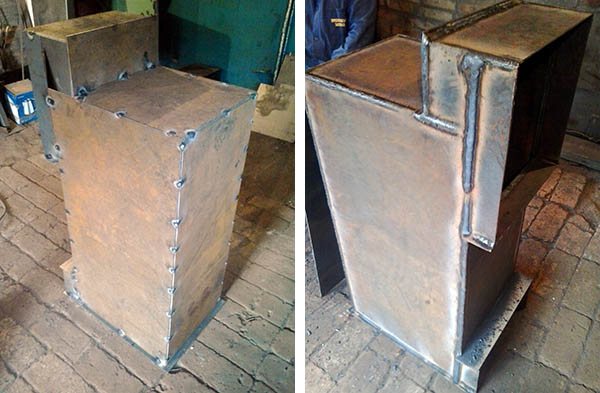

Welding walls
Next, you need to insert a water coat. Material - 3 mm metal. Its thickness at the side walls should be 2 cm, therefore a steel strip is welded to the firebox, produced by 20 mm. You need to grab sheets of steel to the walls - sheathing.
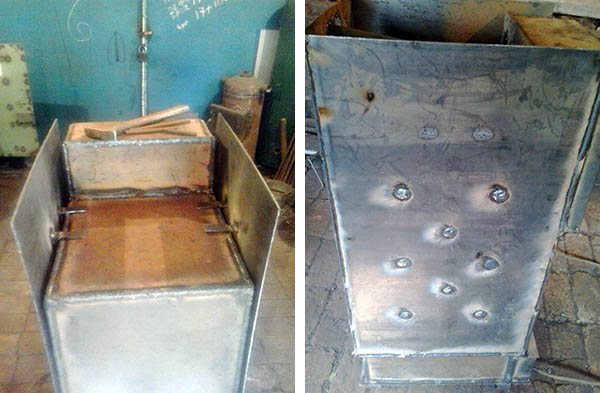

Tank walls
It is important to take into account that the water coat must originate at the level of the grate. It should not wash over the ash compartment.
Further, as you can see in the photo, you need to install the clips in a checkerboard pattern. It should be butt-welded to the firebox with one end, and the other should be welded around the hole.
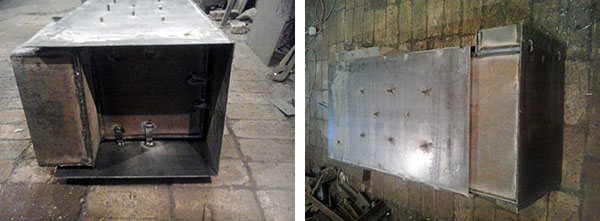

From the photo, you can determine where to place the bottom of the water coat.
Next, the pipes are installed through which the heat will escape. They are placed in the upper part of the mine boiler tank. As shown in the drawing, holes must be cut at the back and front where these pipes will be placed. Their ends must be well scalded, like the rest of the joints of the water coat.
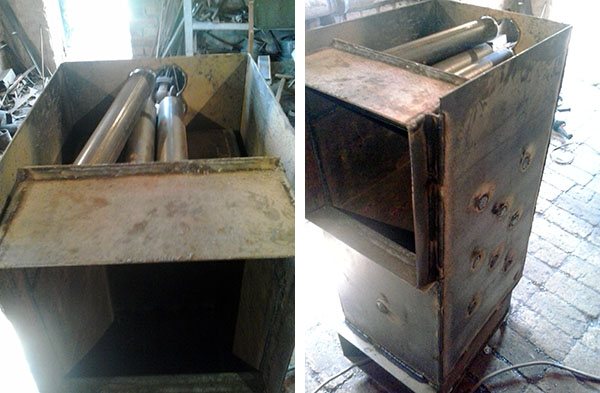

These pipes should diverge in the form of a fan.
The next stage is the installation of the doors and grate. It is necessary to weld a strip in 2 rows to the door in the inner part. An asbestos cord is inserted between the parts, which will seal the porch. The outer corner of the grate must be welded downward. This will dissipate the air that is blown into the ash compartment by the fan.


Grate
After completing all the activities, you need to cut the fittings into the walls of the mine boiler. They will be joined by pipelines: supply and return. The air duct should enter the ash compartment near the middle of the rear wall. It is located right under the water coat.
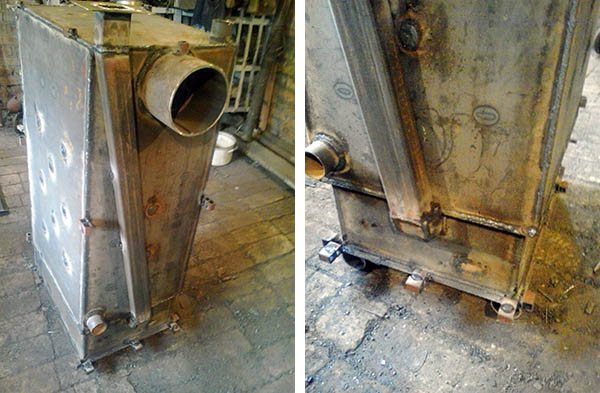

Installation of pipelines
After that, it is necessary to weld the door hinges and embedded parts that will help to install the decorative trim.


Hinges
Long-burning boiler tank must be lined with insulation on each side. You can fix it with a cord. There is little left: screw the neat metal sheets to the details and put the door on.
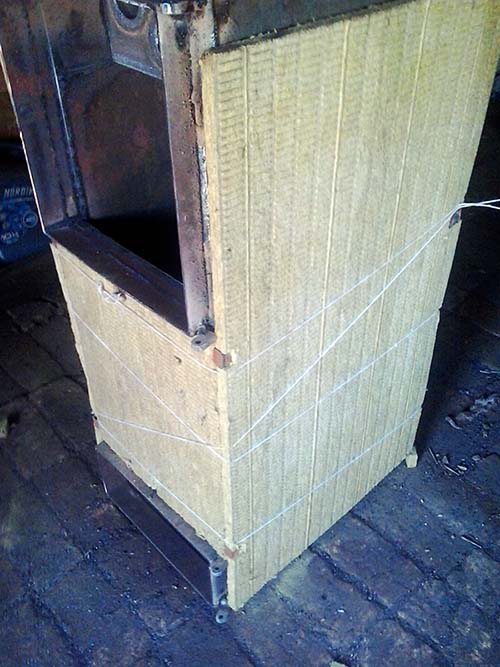

No need to use glass wool or other materials. Basalt insulation does its job well.
A fan must be attached to the air duct flange, and the purchased control unit must be installed. The temperature sensor should be located under the basalt insulation near the rear of the unit. It is possible to install additional units in the boiler, otherwise called "bragman", which will be useful:
- An additional water tank can be installed where the water will be heated.
- In the event of a power cut, an immersion well for a thermometer can be installed.
- Install a heating element that can heat up the water after the firewood has completely burned out.
The legs for the unit are welded at any stage of work. For this, suitable metal pieces are used. Below are the diagrams of the mine boiler.
Advantages and disadvantages
The mine unit has the following main advantages:
- Versatility, availability of work on different types of fuel, including liquid for modified installations.
- High boiler efficiency, productivity and autonomy without additional fuel loading up to 24 hours.
- Clever design for easy maintenance, loading / unloading is done through separate hatches.
- Reliability and safety, therefore, the gas contamination of the premises and carbon monoxide poisoning, one might say, are reduced to "zero".
The disadvantages include:
- increased soot formation and tar formation during fuel combustion;
- huge dimensions of the installation.
Recommendations and operating experience
Many people mistakenly believe that if you increase the area or the number of heat exchangers inside the chamber, this will increase the efficiency of the boiler. In fact, the greatest amount of heat is obtained precisely in the radiation part - about 60-70%.
It is recommended to lay firewood along the grate, and not across it, this will provide better and more uniform fuel combustion. The boiler is loaded either completely every 12-16 hours or periodically put it on. Ash must be cleaned once every 2 days. The heat exchanger is cleaned once every half a month.
Kholmov's boiler is rapidly gaining temperature. When fully loaded, it reaches extremely high temperatures in just 20 minutes. For 1 hour of heating, 3 kg of briquettes are required. When fully loaded with this fuel, it heats up for about 13 hours, dry birch (36 kg) burns for up to 9 hours. In some cases, the boiler could not work in the off-season, when the supply temperature was required up to 50 °, as well as at the minimum mode. Holmov himself advises avoiding the use of the smoldering regime.
At the first start-up, compulsory pressure testing of the boiler under a pressure of 1.5 atm with air, having previously coated the seams with soapy water.
It is recommended to purchase a Kholmov boiler only from a trusted manufacturer and subject to a contract.
Production of a mine pyrolysis boiler
Modified PCs are in great demand today, with high efficiency, allowing you to save a significant amount of fuel and functioning from one filling for more than a day. The simplicity of the design makes it possible to manufacture a boiler with even a little experience in welding.


Drawing of an ordinary pyrolysis boiler
The basis for creating an effective Kholmov boiler with your own hands will be reliable design documentation: drawings, specifications and calculations, which can be found on the Internet today.
When choosing the desired drawing of the unit, they pay attention to the volume of loading of the device, the larger it is, the longer the work will be and what the power of the heat generator depends on.


Algorithm for creating a boiler with your own hands.
- They carry out the main part of the device and divide it into two chambers, installing partitions and valves for air supply.
- A diagram of parts is transferred to a metal sheet and cut out by autogenous.
- Side elements are welded with a reinforced seam.
- 2 holes are cut between the boiler and the firebox in the partition - at the top and bottom near the grate.
- Install the details of the firebox and scald them.
- Attach the latch at the upper hole and secure it.
- The grates are made with cutting of narrow longitudinal slots.
- The grates are placed on metal corners (cast iron) or welded (steel).
- Doors of the firebox and ash pan are made.
- A boiler is installed and welded from pipes of 25 mm with a water jacket.
- Arrange the afterburner chamber of the smoke-gas mixture by welding a partition next to the grate.
- A hole is made at the bottom for installing a 50 mm air pipe with a blind damper at the outlet end and many holes to create a uniform air flow.
- The combustion chamber is insulated with chamotte, and then it is additionally insulated with basalt wool, which increases the thermal efficiency of the boiler unit.
- Further, the installation of the manufactured equipment, the piping of the water and smoke and gas paths, the installation of heating, and then the pressure testing of the system are carried out.
Ways to implement long-term burning
The main problem that plagues users of wood-fired boilers is the lack of long-term burning. We have to regularly throw new portions of firewood into their furnaces. And if during the day it is still possible to somehow come to terms with this, then at night the problem is exacerbated - if you do not pay due attention to the equipment, the fuel will go out. Within an hour after the decay, the temperature in the rooms will begin to drop.
This problem can be solved in a rather interesting way - to build an electric heater (TEN) into the wood-fired boiler. We will not get long burning here, but the heating element will be able to maintain a certain temperature in the circuit, providing users with heat. True, this approach is fraught with a large consumption of electricity - in a month it can "burn up" up to several thousand rubles, depending on the area of home ownership and the capacity of the heating element itself.
Solid fuel boilers for long burning, running on wood and coal, completely solve the problem with frequent loading of fuel. Some of them can burn for up to several days, providing consumers with warmth. Long-term burning is realized in several ways:
- Increasing the volume of the combustion chamber several times;
- Using the pyrolysis combustion scheme;
- By partially automating the fuel supply.
Let's see what the application of certain techniques will give us.
Best Mine Boilers
Pyrolysis type SCs are in demand today among the population living in one-story and two-story houses, since they have proven their effectiveness and demonstrated ease of use.


The market quickly reacted to the requests of buyers and was filled with a wide variety of units of domestic and foreign manufacturers.
In the online shopping ratings in 2020, the greatest demand is for units with a service life of more than 20 years and innovative heating surfaces.
Main characteristics of mine boilers.
| Indicators | Pyrolysis 43 Kp-10 | Heiztechnik (12 kW | Wirbel ECO CK Plus 25 |
| Price | RUB 67100 | RUB 215760 | RUB 277 845 |
| Model | 66694 | 90128 | 80023 |
| Manufacturer | Pyrolysis 43 | Heiztechnik | Wirbel |
| Short description | Duration of work on 1 tab is up to 10 hours. Efficiency 85% to 90%. Energy intensity, Low fuel consumption Automatic maintenance of heating temperature. | Power 12 kW, new EU, innovative technology. Environmentally friendly heating installation with an improved self-igniter burner and a self-cleaning system. Efficiency - 91%, heating temperature - 85 C. | Universal unit for liquid and solid fuels. The range of the heated medium is 40/90 C, the efficiency for solid fuel is 85%, for liquid fuel - 90% |
| Power, kWt: | 10 | 12 | 25 |
| Weight, kg | 210 | 350 | 271 |
| Dimensions (HxWxD), mm | 1070x500x800 | 1370x1150x550 | 1260x915x1070 |
| Chimney diameter, mm | 160 | 150 | 160 |
| Producing country | Russia | Poland | Germany |
Thus, summing up the line, it can be argued that shaft-type boilers are efficient devices with low specific fuel consumption. Such units are today used for individual heating of residential and public ones, significantly reducing owners' heating costs.
